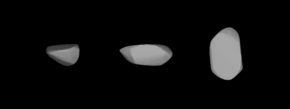Our website is made possible by displaying online advertisements to our visitors.
Please consider supporting us by disabling your ad blocker.
302 Clarissa
 A three-dimensional model of 302 Clarissa based on its light curve | |
| Discovery | |
|---|---|
| Discovered by | Auguste Charlois |
| Discovery date | 14 November 1890 |
| Designations | |
| (302) Clarissa | |
| A890 VA; 1909 YA 1929 CK1; 1946 UN 1948 ED; 1953 NN | |
| Main belt | |
| Orbital characteristics[1] | |
| Epoch 31 July 2016 (JD 2457600.5) | |
| Uncertainty parameter 0 | |
| Observation arc | 124.04 yr (45,305 d) 124.04 yr (45305 d) |
| Aphelion | 2.67 AU (400.04 Gm) |
| Perihelion | 2.14 AU (319.61 Gm) |
| 2.41 AU (359.82 Gm) | |
| Eccentricity | 0.11175 |
| 3.73 yr (1,362.5 d) | |
| 213.798° | |
| 0° 15m 51.174s / day | |
| Inclination | 3.41369° |
| 7.85637° | |
| 54.5926° | |
| Physical characteristics | |
| Dimensions | 38.53±3.1 km |
Mean density | 1.5 g cm−3[2] |
| 14.381 h (0.5992 d) | |
| 0.0524±0.010 | |
| F | |
| 10.89 | |
302 Clarissa is a typical main belt asteroid.[1] The asteroid was discovered by the French astronomer Auguste Charlois on 14 November 1890 in Nice. The origin of the name is unknown.[3] In 1991, 302 Clarissa was being considered as a possible fly-by target for the Cassini spacecraft, but was later removed from consideration.[4]
This body is orbiting the Sun with a period of 3.73 years and an eccentricity (ovalness) of 0.11. The orbital plane is inclined by 3.4° to the plane of the ecliptic. There are no major planetary resonances near the orbit of 302 Clarissa. It has a retrograde spin with a rotation period of 14.4797 hours. Stellar occultation data provides a size estimate of 43±4 km,[2] while IRAS data gives a diameter of 38.5±3.1 km. It is classified as a F-type asteroid and is probably composed of carbonaceous material.[1]
302 Clarissa provides the eponym for a small collisional asteroid family of mostly C-type asteroids. This group consists of 179 bodies with orbits clustered around 302 Clarissa. The family has a small extend of semimajor axis values, suggesting this is a young group; its estimated age is 56±5 Myr. 70–90% of the objects in this family have a retrograde spin, suggesting the parent body may have possessed a similar rotation.[2] This family is one of five that are candidate sources for the near Earth asteroids 101955 Bennu and 162173 Ryugu.[5]
- ^ a b c Cite error: The named reference
jpldatawas invoked but never defined (see the help page). - ^ a b c Cite error: The named reference
Lowry_et_al_2020was invoked but never defined (see the help page). - ^ Cite error: The named reference
Schmadel2013was invoked but never defined (see the help page). - ^ Cite error: The named reference
Chevreton_et_al_1993was invoked but never defined (see the help page). - ^ Cite error: The named reference
Morate2018was invoked but never defined (see the help page).
Previous Page Next Page


